
– Now available in paperback on amazon.com –
https://www.amazon.com/gp/product/1683830067/ref=od_aui_detailpages01?ie=UTF8&psc=1
To preface, as related by Angela Cartwright on her website publications page:
“Styling the Stars: Lost Treasures from the Twentieth Century Fox Archive is a stunning collection of never-before-seen continuity photographs, offering readers an intimate, candid look at Hollywood’s golden age and beyond.”
Review by Lorraine Dmitrovic. (Please note: This is an objective review of the book I purchased, and I did not receive compensation.)
FIVE STARS!
The moment is breathtaking and truly unforgettable. As the actress or actor steps onto the screen, they sparkle and shine, eclipsing and stealing thunder from the mountain range scenery or the salon backdrop. They transcend the set and have luminous, glorious presence. They certainly have “it” – and something else standout special – the “style” that ultimately made them stars.
The authors, actor Tom McLaren and actress-artisan Angela Cartwright, found the magic pulse for the book when searching through the Twentieth Century Fox archives. What emerged was the amazing star quality found in remarkably pristine continuity photos of a history of the studio dating back to the 1930s. Angela revealed in her introduction that many of the photos from the 1920s, and scripts and contracts, etc., however, had been thrown out in the 1970s when the studio was downsized. Thankfully, enough excellent original material survived so that Tom and Angela could preserve the wonder of a bygone film era in the book.
Angela also concluded that growing up in the studio life of Twentieth Century Fox was like “being plopped in the middle of a small city.” The lot had its hustle and bustle of various buildings and inner workings all with the common goal of producing the highest quality movie possible in talent and visual appeal.
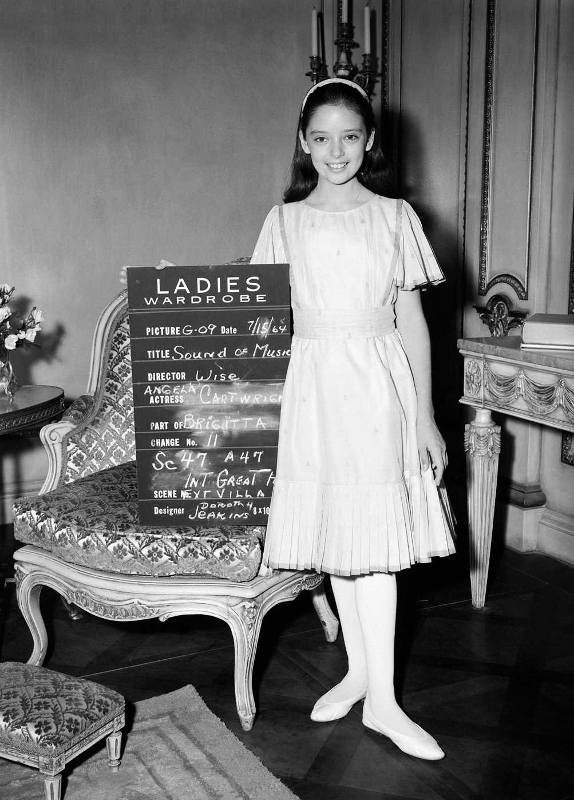
Photo: Angela Cartwright, Sound of Music (1965)
Tom and Angela have created a masterpiece collection of photos from the archives, a visual log of what went on behind the scenes in preparing a cast for filming, to make them “camera-ready” and ready to make movie history. Really, movie plot aside, what do people talk about when they exit the theatre? Not popcorn or soda, but the gown that had been poured onto Marilyn Monroe, or the dapper hat carried by dressed-to-the-nines Cary Grant in An Affair to Remember (1957). (Cary also graces the back cover in bathing trunks in a wardrobe test photo for the same film.)
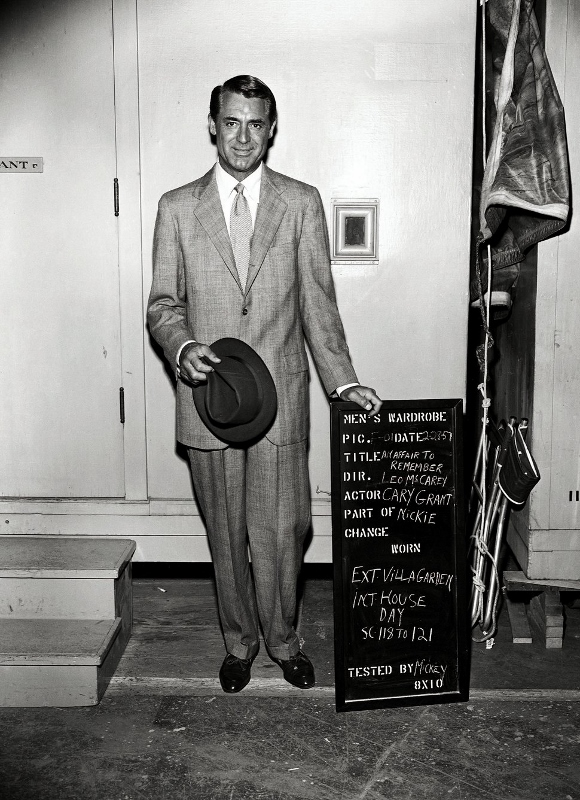
Photo: Cary Grant, An Affair to Remember (1957)
In Hollywood’s heyday, studios took every aspect of filmmaking seriously. Everything on screen and behind it was as important as the acting. Actors and actresses were groomed to be stars in every sense of the word. Eye appeal was as much a key to success for a film as talent, the directing, the cinematography and settings. Actresses and actors had to stand out against already spectacular set designs and locations. And style was a major way to set them apart from the background. Call it star power, a spell of beauty, but it comes down to a lot of designer thought, planning and hard work to create “the style” of the stars in a film.
On set, on location, even at publicity events and award ceremonies, stars often relied on fashion/costume designers, hair stylists, make-up artists and wardrobe people for touch-ups and adjustments, to ensure everything was ready, perfect and in continuity for the camera to roll. Jewellery and hats, millinery, purses, shoes and accessories, all had to be organized and kept track of during the filming of scenes. Head to toe, the stylists, designers and jewellers, and all others involved the process, had the talent “covered” and turned out to magnificent perfection for the camera and the public, who often relied on Hollywood for the next big fashion trend.
Not a single detail was overlooked in what was required to pull a look together. No pennies were pinched; every expense was worth the glamorous or the gritty effect. The mink stole Marilyn Monroe wears in the cover photo – the image chosen by Angela Cartwright herself for the cover – is real. Quality in styling is evident in the flash of genuine diamonds, in the elegant lines of designer gowns, and in the cut and tailoring of suits. Authenticity and ingenuity in costumes encouraged audiences to admire the dazzle along with the story and step into a different dark world or a beautiful dream for the price of a theatre ticket.
Maureen O’Hara’s foreward mentions a “backroom deal” to own part of her contract that brought her to Twentieth Century to star in How Green Was My Valley (1941) with John Wayne, and Miracle on 34th Street (1947). She credits Darryl F. Zanuck’s mantra of “Time is money!” and his demand that stars be “camera ready” for their roles as being major reasons for success of the studio.
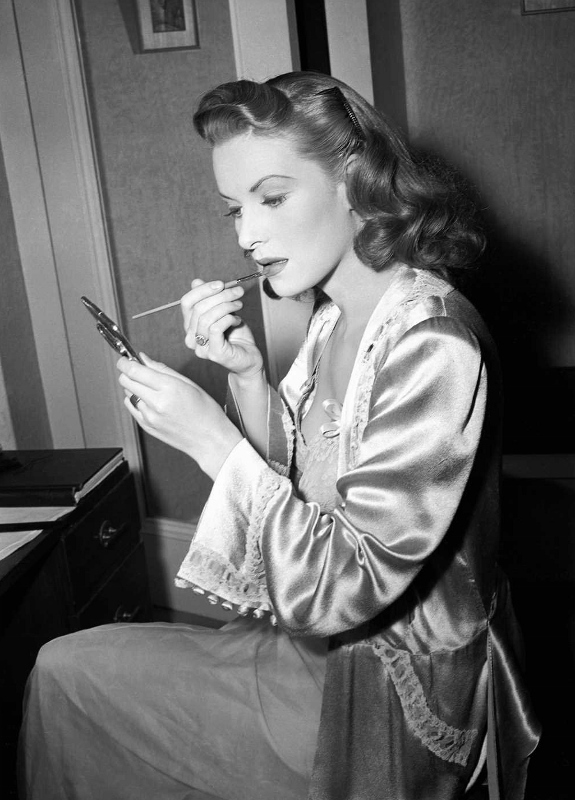
Photo: Maureen O ‘ Hara in her foreward to Styling the Stars, from her movie Do You Love Me (1946)
It was a “look the part and feel the part” thing, really. The right clothes, hair and make-up were as essential to a character as a well-made prop. Maureen wrote about her character Doris in Miracle on 34th Street: “Being camera ready allowed me to bring Doris Walker to life in a more textured way. If you don’t look right and feel right in the story it can pull you out of character and hurt your performance. When those elements came together as nicely as they did on Miracle, I was able to offer more about Doris through style and movement. It is very freeing when everything fits and works.”
Photos in the book encompass everything imaginable about “styling those stars” at many stages and places of the process, showing in grand detail what went into making the stars camera ready – indoors, outdoors, fitting rooms, during filming, with film information and the character most often chalked on a large board placard. Test photos and wardrobe continuity photos for future reference in later filmed scenes have turned out to be some of the most important photographs taken by Twentieth Century.
The sheer number and range of actors and actresses chosen by Tom and Angela is mind-boggling. Shirley Temple, whose films actually saved the studio from bankruptcy in the 1930s, is captured in her famous ringlets and costume photos from various films. John Carradine touches up pancake powder on his forehead between scenes of Drums Along the Mohawk (1939). You find out how tall Gregory Peck really was – a wardrobe assistant has to stand on a platform and a medium size case to adjust Peck’s tie while filming Gentleman’s Agreement (1947). Henry Fonda shaves his own stubble as a wardrobe person holds a small mirror during the filming of The Grapes of Wrath (1940). Tom Noonan is tested for the right pair of glasses for a role. David Hedison is photographed for The Fly (1958) in a lab coat and a black cloth totally covering his unhuman head. Patricia Neal in a prim collared dress holds giant Gort’s hand for The Day the Earth Stood Still (1961). Jane Russell looks every bit the cowpoke as Clark Gable does in a 2-page spread for The Tall Men (1955).
 Photo: Tyrone Power, The Mark of Zorro (1940)
Photo: Tyrone Power, The Mark of Zorro (1940)
Dean Martin made at least five costumes changes, two military uniforms and three suits for The Young Lions (1958). Victor Mature as Demetrius looks marvellously hunky for a marketplace scene in The Robe (1953) in lace-up boots, leather apron and rustic striped shirt. Barbara Stanwyck, Anne Bancroft, Louis Jordan, Rock Hudson, Bette Davis, Joan Crawford. Angela Cartwright’s sister Veronica, and yes, Billy Mumy too, Angela’s co-star from the 1960s sci-fi TV series Lost in Space. And more …. Suffice it to say that many, many stars – such as Joan Crawford, Bette Davis, Rita Hayworth, Humphrey Bogart and Lauren Bacall, Audrey Hepburn Frank Sinatra, Katharine Hepburn and Spencer Tracy – from some of the greatest films and TV productions ever made, made it into Tom and Angela’s book.

Photo: Candice Bergen, The Magus (1968)
Among the top costume designers, Edith Head had to work within a small budget on Butch Cassidy and the Sundance Kid (1969) and after designing and creating only one complete costume, Robert Redford’s ensemble was piece-mealed together from older costumes in the studio’s wardrobe department.
Other esteemed designers who also styled stars for Twentieth Century Fox include: Dorothy Jeakins (The Sound of Music), Rene Hubert for Music in the Air (1934), starring Gloria Swanson, William Travilla (who dressed Marilyn Monroe for 8 films), Charles Le Maire, Marie Wills, Renie Conley, and the Sorelle Fontana fashion house, Adele Palmer (who designed Veronica Cartwright’s gingham dress for In Love and War (1958); Veronica recalls eating gallons of “chicken soup all day” during the filming). M. Best, J. Lovis, R. Agnayan, Irene Sharaff and more ….
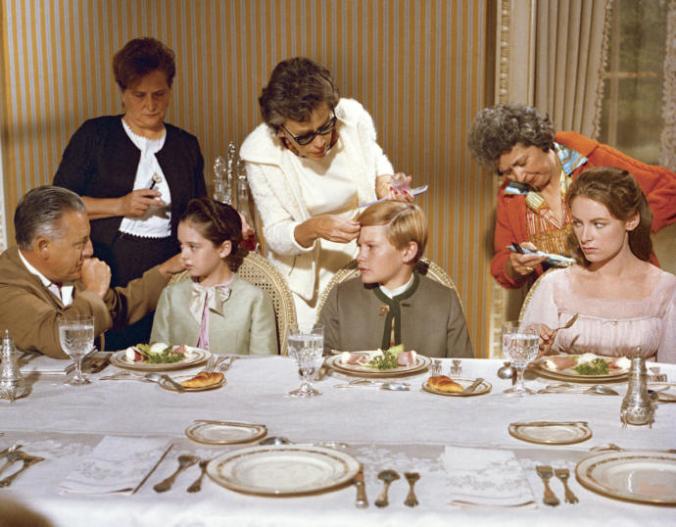 Photo: The Sound of Music (1965) Direction from Robert Wise and touch-ups at the table. Dorothy Jeakins, designer
Photo: The Sound of Music (1965) Direction from Robert Wise and touch-ups at the table. Dorothy Jeakins, designer
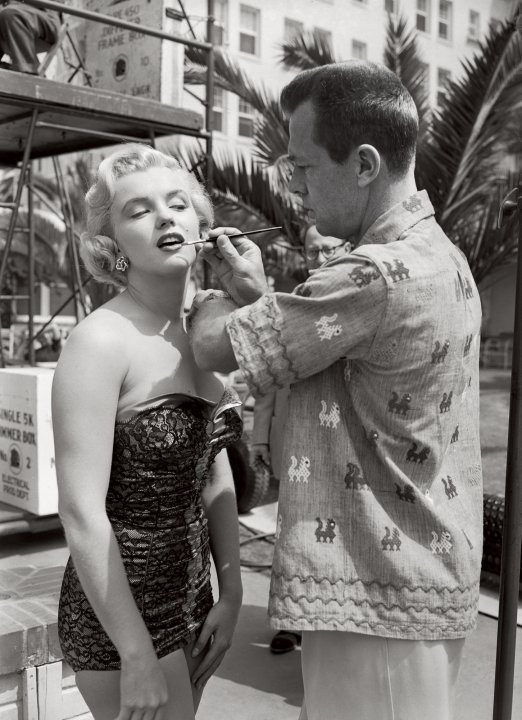
Photo: Marilyn Monroe, brushing on a little lipstick, Let’s Make it Legal (1951)
The surprises keep on coming. Intriguing photos were included of Raquel Welch in a plaster cast mold so that a form-fitting costume for Fantastic Voyage (1966) could be designed. A section for The Valley of the Dolls (1967) featured ultra-mod “groovy” dress designs and some spectacular outlandish hairstyles (and simple does as well) – and a photo of a happy Judy Garland as Helen Lawson before she was replaced by Susan Hayward in the role.
 Photo: Rita Moreno, The King and I (1956)
Photo: Rita Moreno, The King and I (1956)
Styling the Stars is a supremely rewarding journey through the best of the Twentieth Century Fox Archive. Every time you pick up the book, you find more to discover. The “lost treasures” in Tom and Angela’s book, now forever found, will stand as a sublime historical record of a studio. All the glory, all the enchanting flair, is relived on every page of Styling the Stars’ 304 pages. This review has only skimmed the surface of its photographic jewels. If a future expanded edition one day becomes available, it could only make this already great Hollywood style book even more perfect.

Q & A feature interview with actor-author TOM McLAREN
Lorraine:
Maureen O’Hara, as a part of Fox’s studio system was a perfect choice to do the Foreward for your book. What do feel are the special qualities Miss O’Hara possessed when it came to the studio stylizing her enduring image?
TOM:
Maureen O’Hara had every quality a movie star needs, most certainly talent and beauty, but also a mesmerizing presence and dazzling uniqueness. Movie fans loved her combination of strength and femininity. Her Miracle on 34th Street (1947) will always be one of Fox’s true classics (my wife’s favorite film). We are very fortunate that Maureen kindly agreed to write the Foreword to the book. I was very touched to learn that she kept a copy of the hardcover edition on her own coffee table, next to her copy of a John Wayne book.
Lorraine:
What was most surprising to you about the stylist process discovered while doing research for the book? What were some incredible archival finds?
TOM:
It was interesting to see the level of detail and perfection that went into the taking of hair/makeup/wardrobe continuity photos. Even though the images were intended for internal studio use only, the photographers took the process very seriously. The quality of these vintage photos (taken by professional photographers using professional camera equipment) was simply stunning. Today, it’s all so quick and disposable; continuity photos are snapped on iphones usually by crew assistants.
So many incredible finds…seeing Marlon Brando, Dean Martin, and Montgomery Clift smiling and having fun while taking their Young Lions photos was a highlight. I loved photos which revealed something about the actor’s personality: Paul Newman and Doris Day making faces, John Wayne and Rita Hayworth always with a cigarette in hand, etc. I treasured the never-before-seen rarities…actors who tested for the film but were not cast (Joan Collins in Cleopatra) or were replaced by other actors (Judy Garland in Valley of the Dolls).

Photo: John Wayne, North to Alaska (1960)
Lorraine:
If the space had been available, what stars and their films would you have also included?
TOM:
There are millions of images in the archive, so the list would be unlimited. There were so many choices from the golden age of Hollywood, we could have spent months, even years, going through those archival boxes. The book goes from Shirley Temple in the 1930s through Faye Dunaway in the 1970s, but it would have been fun to dig for more. Images shifted towards polaroids in the 1970s, which was a time of lower quality photography. We wanted this book to showcase pristine quality negatives only.
Lorraine:
Many of Hollywood’s legendary stars and future celebrities are found within the pages. At times with perhaps many photos available of a star, what were the criteria for choosing images? Were all the Fox archive photos already dated and described, or on occasion did you have to engage in some sleuthing to uncover all the facts?
TOM:
Our first choice was to showcase wardrobe photos with the chalkboard placard next to the actor (see back cover photo of Cary Grant) and hair/makeup photos with the note card or hair brush as the indicator (see front cover photo of Marilyn Monroe). If those images were not available, we would choose behind the scenes photos where the stars are being styled during the hair/makeup/wardrobe process. Both types of images are fascinating for so many reasons. It’s a candid moment of the star working on set. It’s a glimpse into the movie making process that so few get to see.
The archival boxes were a complete mystery…we didn’t know what was in them until we opened them! The individual images were not cataloged or categorized in any way. We would literally hold up the negatives to the light or place them on a light box in an attempt to see who it was and what they were doing. The A-list leading actors were of course easiest to spot. The other actors in the film required some sleuthing. Fortunately, I have one of those minds filled with movie trivia and actors’ names/faces/credits/etc, so most were easy to identify.
 Photo: One of the mysteries unveiled, Bing Crosby as Harv in a gown and wig for High Time (1960). He was also wardrobe-tested in a men’s traditional casual outfit
Photo: One of the mysteries unveiled, Bing Crosby as Harv in a gown and wig for High Time (1960). He was also wardrobe-tested in a men’s traditional casual outfit
Lorraine:
Many of the younger studio actresses went on to become established stars and later on became stars to new generations – finding audiences as well into the 21st century. Groomed-into-stars like Julie Newmar, Barbara Eden and Ann-Margret are living legends today. How do you feel knowing that your book contains the best of Hollywood, then and now?
TOM:
It was very important to me to represent both my parent’s generation and my own generation in the book. My parents had their favorite golden era movie stars and I grew up watching TV reruns of those classic films. But I also developed my own tastes for TV and film when I was a teenager, so I have my ‘next generation’ favorites, many of whom I first discovered on television like Barbara Eden, Robert Wagner and Julie Newmar. The inclusion of the film Myra Breckinridge in the book is a perfect example of one of my goals: Mae West from Old Hollywood and Raquel Welch and Farrah Fawcett from New Hollywood. Something for everyone!
 Photo: Ann-Margret, The Pleasure Seekers (1964)
Photo: Ann-Margret, The Pleasure Seekers (1964)
Lorraine:
Are there any personal favourites among the array of stars included?
TOM:
It’s a long list! My parent’s favorites are all in there, from Errol Flynn to Barbara Stanwyck. My wife’s favorites are included from Doris Day to Robert Redford. Ann-Margret has always been a favorite of mine, so she was at the top of my wishlist. The wardrobe shot of glamorous Ann-Margret in her iconic flamenco dress from The Pleasure Seekers (1964) , while standing in front of a barrage of technical equipment on a sound stage, is perhaps my favorite never-before-seen photo in the book. I’m also thrilled to include photos of my dear friends Susan Blakely and Lindsay Wagner. The softcover edition has one additional photo which the hardcover does not have: Lindsay Wagner from The Paper Chase (1973).
Lorraine:
Why did you choose to focus on the styling of stars from the Twentieth-Century Fox studio, as opposed to another studio? Although a number of stars in the book did work before, were loaned out during, or after, with other studios, what was the special appeal of the Twentieth Century roster for you?
TOM:
Angela had visited the Fox Archive looking for photos from her movie The Sound of Music (1965) for another book project of hers (The Sound of Music Family Scrapbook). The idea for Styling the Stars started there, when she realized all the Fox films had boxes of long forgotten images. The quality of these never-before-seen photos was the real hook. She called me on the phone and asked me to join her on this journey – I jumped at it immediately – and then we got the studio and our publisher Insight Editions on board.
Every major star from the 1930s through the 1970s did at least one Fox film. They may not have been Fox contract players, but loan outs and independent periods allowed the major movie stars to work at Fox at some point in their careers. We knew we’d find everyone from Humphrey Bogart to Bette Davis to Clark Gable. Fox film history is filled with treasures!

Photo: Jayne Mansfield, Will Success Spoil Rock Hunter? (1957)
Lorraine:
How did you and Angela cross paths and how did that develop into a working relationship for writing Styling the Stars?
TOM:
Angela and I met about 20 years ago at a Lost in Space event. (I was, and still am, a huge Lost in Space fan.) At the time she was curator at a Los Angeles art gallery and she invited me to an exhibit opening. My wife and I became regular patrons at this beautiful gallery and over time we got to know Angela and her family. They are such great people. Angela is a part of movie history certainly, but I see her now as my friend Angela – a kind, interesting, and very dear friend.
She knew my background was in corporate business, and that I was a movie lover and memorabilia collector, so my project management skills and personal interests were well-suited to this book project. The combination of our creative strengths and interests made us a great duo. We worked arm in arm, through thick and thin. The book was definitely a two person project, very complex but extremely rewarding. Overall, I would say this was a dream project for me, and to have worked on it jointly with Angela made it truly a once in a lifetime book that I’m very proud of!

Tom: Catching up with photos from our recent book signing at the grand opening of Giddy in Scavenger’s Paradise in Burbank. Angela Cartwright and I had a great time signing our Insight Editions hardcover and softcover book Styling the Stars. Thank you to Alyssa from Giddy Vintage for hosting us. (Alyssa Lauren Gullion is the owner of Giddy Vintage.) Thank you to Jeanne from Cookie Jar Treats for providing the delicious sweet treats. It was wonderful seeing all the family, friends, and newcomers who came to support us.

Tom: The cookies were made by my sister-in-law Jeanne. She has a great food blog and goes under “cookiejartreats” in social media. She’s a great baker.

Q & A featurette with actress-artisan ANGELA CARTWRIGHT
Lorraine:
You “grew up” knowing and being acquainted with many of the stars included in Styling the Stars. What might be a fond and meaningful memory for you of any actress or actor in the book?
ANGELA:
I have worked with many of the stars in the book… but working with Julie Andrews was indeed memorable. As kids we adored her from the moment we met her. She sang and joked with us between takes. It shows in the movie how enchanted we all were with her.
Lorraine:
Describe how you feel about the magic process of a “not made up” actress or actor going through the transformation of becoming “the star.” How you feel about all the unique and special styling of hair, make-up and wardrobe involved in creating the styled image? The actor into the character can result in a quite a different ‘night and day’ appearance.
ANGELA:
There is so much more to becoming a character than just learning lines and speaking in a voice to make it real. The costumes, makeup, appearance is all a part of it. Even accessories a character carries can aid in the audience accepting a character. It’s all a “secret dance” to have the audience not think about the actor but to accept that this person they are portraying is real.
More info:
View the Insights Edition trailer for Styling the Stars on You Tube:
Visit Tom McLaren’s website:
http://www.tom-mclaren.com/
Visit Angela Cartwright’s website:
http://www.angela-cartwright.com/
All review photos for Styling the Stars courtesy of Insight Editions
“There is so much more to becoming a character than just learning lines and speaking in a voice to make it real. The costumes, makeup, appearance is all a part of it. Even accessories a character carries can aid in the audience accepting a character. It’s all a “secret dance” to have the audience not think about the actor but to accept that this person they are portraying is real.”
Angela Cartwright’s response to your question about characters is going to help me write about the characters in my next story, and bring them to life!
LikeLiked by 1 person
Point by point, Angela’s reply to my question is certainly also a wonderful checklist for writers seeking to develop well-rounded believable characters. I’m glad that Angela’s response was helpful, Larry.
LikeLike